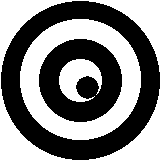THE HONOUR
This a formal obeisance made by partners to one another at the conclusion, and sometimes in the course, of the dance. The man bows, head erect, making a slight forward inclination of the body from the hips; the woman, placing her left foot behind the right, makes a quick downward and upward movement by bending and straightening the knees.
The honour should always be made in rhythm with the music and, if possible, in conjunction with some corresponding movement of the feet. The exact way in which this is done depends upon circumstances. The usual method is to place the right foot on the ground twelve inches or so to the side say, on the first beat of the bar, and to bring up the left foot beside it - or, in the case of a woman, behind it - on the following beat when the obeisance is made.
THE SET
This is a movement of courtesy, addressed by one dancer to another, or more frequently by two dancers to each other simultaneously. It consists of a single to the right sideways, followed by a single to the left back to position (two bars).
THE SET-AND-HONOUR
This is a lengthened form of the Set occupying four instead of two bars. On the first beat of the fist bar the right foot is placed on the ground sideways to the right; on the first beat of the second bar the left foot is brought up beside it and the honour paid in the manner already explained (two bars). These movements are then repeated in the reverse direction, the left foot being moved to the side, the right foot brought up beside it, and the honour paid (two bars, i.e., four bars in all).
THE SIDE
This is performed by two dancers, usually partners, but not necessarily so.They face each other, and move forward a double obliquely to the right, i.e., passing by the left. On the third step they make a half-turn counter-clockwise, completing the turn on the fourth step as they face one another (two bars). This completes the first half of the movement, and it is called side to the right. In the second half of the movement, side to the left, the dancers retrace their steps along the same tracks, moving obliquely to the left (passing by the right), turn clockwise, and face each other on the fourth step. The whole movement occupies four bars of the music.The dancers must remember to face each other at the beginning and close of each movement, to pass close to each other, shoulder to shoulder, and always to face in the direction in which they are moving.
ARM WITH THE RIGHT (OR LEFT)
Two performers, usually partners, meet, link right (or left) arms, swing round a complete circle, clockwise (or counter-clockwise) (two bars), separate, and fall back to places (r.s.) (two bars, i.e., four bars in all).In order that the dancers may give and receive mutual support in the execution of the whole turn, the arms, crooked at right angles, must be linked at the elbows, the dancers lean slightly away from each other, so as to throw part of their weight on their arms.
Page transcribed by Hugh Stewart
